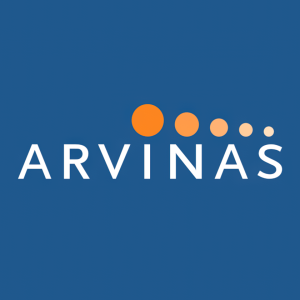Arvinas Presents Late Breaking, Positive Phase 1 Clinical Data for ARV-102, a PROTAC LRRK2 Degrader, at the 2025 International Congress of Parkinson’s Disease and Movement Disorders®
Rhea-AI Summary
Arvinas (Nasdaq: ARVN) announced late‑breaking Phase 1 data for ARV-102, an oral brain‑penetrant PROTAC LRRK2 degrader, presented at MDS 2025 on Oct 5, 2025.
The PR states ARV-102 was generally well tolerated (single doses up to 200 mg; multiple daily doses up to 80 mg) with no discontinuations or SAEs. Plasma and CSF exposure increased dose‑dependently, indicating brain penetration. The PR reports >90% PBMC LRRK2 reductions at ≥20 mg and median PBMC reductions of 86% (50 mg) and 97% (200 mg) in patients. In healthy volunteers, 14 days of 80 mg produced CSF proteomic decreases in lysosomal and microglial pathway markers linked to Parkinson’s disease.
Positive
- Well tolerated up to 200 mg; no SAEs or discontinuations
- Dose-dependent CSF exposure indicating brain penetration
- PBMC LRRK2 reductions >90% with repeated daily doses ≥20 mg
- CSF proteomics: reduced lysosomal and microglial markers after 14 days
Negative
- Small Parkinson’s trial cohort: 15 treated, 4 placebo
- Reported data are interim/single‑dose; multiple‑dose results pending 2026
Insights
Phase 1 data show ARV-102 is brain‑penetrant, well tolerated, and modulates CSF lysosomal and microglial biomarkers linked to Parkinson’s disease.
What it means: The article reports that ARV-102 produced dose‑dependent exposure in plasma and CSF, indicating brain penetration, and achieved >90% LRRK2 reductions in PBMCs at ≥20 mg and median PBMC reductions of 86% and 97% at 50 mg and 200 mg in patients. The trials showed tolerability with no discontinuations for AEs or SAEs and only mild treatment‑related events in the patient cohort.
Why it matters: Direct CSF exposure plus rapid peripheral target degradation and early CSF proteomic changes provide three distinct, disclosed lines of evidence—pharmacokinetics, pharmacodynamics, and pathway biomarker modulation—that together strengthen the chain of biological activity for a brain‑directed LRRK2 degrader. The reported decreases in lysosomal and neuroinflammatory microglial markers in CSF after 14 days link target engagement to downstream pathways previously observed in LRRK2 Parkinson’s disease, supporting further clinical development.
Notes and near‑term milestones: The article states Arvinas will present multiple‑dose patient data in 2026 and, pending those data and IND clearance, intends to start a Phase 1b trial in progressive supranuclear palsy in the first half of 2026.
– ARV-102 was well tolerated in clinical trials for both healthy volunteers and patients with Parkinson’s disease –
– ARV-102 demonstrated dose-dependent cerebrospinal fluid (CSF) exposure in subjects in both trials –
– After 14 days of treatment in healthy volunteers, ARV-102 decreased lysosomal and neuroinflammatory microglial pathway biomarkers known to be elevated in Parkinson’s disease –
NEW HAVEN, Conn., Oct. 05, 2025 (GLOBE NEWSWIRE) -- Arvinas, Inc. (Nasdaq: ARVN), a clinical-stage biotechnology company creating a new class of drugs based on targeted protein degradation, today announced positive pharmacokinetic, pharmacodynamic, and biomarker data from two Phase 1 clinical trials evaluating ARV-102, an oral, brain-penetrant investigational PROTAC degrader of leucine-rich repeat kinase 2 (LRRK2). Results were presented at the International Congress of Parkinson’s Disease and Movement Disorders® (MDS 2025) in Honolulu.
“We are particularly excited by the CSF proteomics results, which demonstrate modulation of lysosomal and microglial pathways that are known to be associated with neurodegenerative diseases,” said Noah Berkowitz, M.D., Ph.D., Chief Medical Officer of Arvinas. “We believe these findings support the intensified development of ARV-102 in ongoing studies of patients with Parkinson’s disease, and in future studies of patients with progressive supranuclear palsy.”
The company presented data from two trials: ARV-102-101, a first-in-human trial of ARV-102 in healthy volunteers, and ARV-102-103, a trial in patients with Parkinson’s disease. Key findings include:
Data from a Phase 1 Single Ascending Dose and Multiple Ascending Dose Trial in Healthy Volunteers (Poster 904):
- Safety: ARV-102 was generally well tolerated at single doses up to 200 mg and multiple daily doses up to 80 mg, with no discontinuations due to adverse events (AEs) or serious adverse events (SAEs) observed in the study population.
- Pharmacokinetics: ARV-102 exposure increased in a dose-dependent manner in plasma and CSF, the latter indicating brain penetration.
- Pharmacodynamics: Repeated daily doses ≥20 mg resulted in >
90% reductions of LRRK2 protein in peripheral blood mononuclear cells (PBMCs) and >50% reductions in CSF. - Pathway Biomarkers: Repeated daily doses of ARV-102 resulted in reduced plasma concentrations of phospho-Rab10T73 and urine concentrations of bis(monoacylglycerol)phosphate (BMP), a sensitive biomarker for modulation of the lysosomal pathway downstream of LRRK2.
Interim Single Ascending Dose Data from a Phase 1 Trial in Patients with Parkinson’s Disease and CSF Proteomic Data from a Phase 1 Trial in Healthy Volunteers (Late Breaking Abstract #22):
- Safety: The Phase 1 trial in patients with Parkinson’s disease included 15 patients treated with ARV-102 and 4 patients treated with placebo. In the trial, single doses of ARV-102 (50 mg or 200 mg) were well tolerated with only mild treatment-related AEs including headache, diarrhea, and nausea; no SAEs occurred.
- Pharmacokinetics: In patients with Parkinson’s disease, ARV-102 exposure increased in a dose-dependent manner in both plasma and CSF, the latter indicating brain penetration.
- Pharmacodynamics: In patients with Parkinson’s disease, treatment with ARV-102 resulted in median PBMC LRRK2 protein reductions of
86% with the 50 mg dose and97% with the 200 mg dose. - CSF Proteomics: In healthy volunteers treated with ARV-102 80 mg once daily for 14 days, unbiased proteomic analyses of CSF showed significant decreases in lysosomal pathway markers and neuroinflammatory microglial markers previously shown to be elevated in patients with Parkinson's disease harboring LRRK2 variants.
“To our knowledge, this is the first time an investigational LRRK2 therapy has, at 14 days in healthy volunteers, shown effects on distal pathway biomarkers in CSF that are elevated in patients with LRRK2 Parkinson’s disease," said John Houston, Ph.D., Chairperson, Chief Executive Officer, and President at Arvinas. "These data highlight the potential of PROTAC-mediated LRRK2 degradation, encouraging further development that could benefit patients in the future."
Arvinas plans to present initial data from a multiple dose cohort of the Phase 1 clinical trial in patients with Parkinson’s disease (ARV-102-103) in 2026. Pending data from the multiple dose cohort and investigational new drug (IND) clearance, Arvinas intends to initiate a Phase 1b trial in patients with progressive supranuclear palsy in the first half of 2026.
Additional detail on Arvinas’ data presentations at the MDS 2025 Congress:
Poster Title: First-in-Human Study to Assess the Safety, Pharmacokinetics, and Pharmacodynamics of Single and Multiple Ascending Doses of ARV-102, a PROTAC LRRK2 Degrader, in Healthy Participants
- Date & Time: Oct. 7, 12:00-1:00 p.m. HST
- Presentation Order: 3
- Poster Number: 904
Presentation Title: First Clinical Trials of ARV-102, a PROTAC LRRK2 Degrader: Characterization of Pathway Engagement in Healthy Volunteers and Patients With Parkinson’s Disease
- Date & Time: Oct. 8, 12:00-1:00 p.m. HST
- Presentation Order: 11
- Poster Number: Late Breaking Abstract 22
Additional information can be found on the MDS 2025 website.
About ARV-102
ARV-102 is an oral, brain-penetrant investigational PROTAC designed to degrade LRRK2, which is a large, multidomain scaffolding kinase. Increased activity, scaffolding, and expression of LRRK2 have been implicated in the pathogenesis of neurological diseases. LRRK2 mutations are a frequent familial cause of Parkinson’s disease, and common LRRK2 variants have been linked with idiopathic Parkinson’s disease and progressive supranuclear palsy.
About Arvinas
Arvinas (Nasdaq: ARVN) is a clinical-stage biotechnology company dedicated to improving the lives of patients suffering from debilitating and life-threatening diseases. Through its PROTAC protein degrader platform, Arvinas is pioneering the development of protein degradation therapies designed to harness the body’s natural protein disposal system to selectively and efficiently degrade and remove disease-causing proteins. Arvinas is currently progressing multiple investigational drugs through clinical development programs, including vepdegestrant, targeting the estrogen receptor for patients with locally advanced or metastatic estrogen receptor–positive (ER+), human epidermal growth factor receptor 2–negative (HER2-) breast cancer; ARV-393, targeting B-cell lymphoma 6 protein (BCL6) for relapsed/refractory non-Hodgkin lymphoma; ARV-102, targeting LRRK2 for neurodegenerative disorders; and ARV-806, targeting Kirsten rat sarcoma (KRAS) G12D for cancers harboring this mutation, including pancreatic and colorectal cancer. Arvinas is headquartered in New Haven, Connecticut. For more information about Arvinas, visit www.arvinas.com and connect on LinkedIn and X.
Forward-Looking Statements
This press release contains forward-looking statements within the meaning of the Private Securities Litigation Reform Act of 1995 that involve substantial risks and uncertainties, including statements regarding: Arvinas’ belief that the data presented from two Phase 1 clinical trials evaluating ARV-102 (ARV-102-101 and ARV-102-103) supports the intensified development of ARV-102 in ongoing studies of patients with Parkinson’s disease, and future studies of patients with progressive supranuclear palsy; the potential of PROTAC-mediated leucine-rich repeat kinase 2 (“LRRK2”) degradation; the potential of ARV-102, including its degradation of LRRK2 and potential future benefit to patients; Arvinas’ plans to present initial data from a multiple dose cohort of the Phase 1 clinical trial of ARV-102 in patients with Parkinson’s disease; and Arvinas’ intention, pending data from the multiple dose cohort and investigational new drug clearance, to initiate a Phase 1b clinical trial of ARV-102 in patients with progressive supranuclear palsy, and the timing thereof. All statements, other than statements of historical fact, contained in this press release, including statements regarding Arvinas’ strategy, development plans, future operations, prospects, plans and objectives of management and the statements identified in the prior paragraph, are forward-looking statements. The words “ability,” “anticipate,” “believe,” “estimate,” “expect,” “intend,” “may,” “plan,” “potential,” “target,” “goal,” “potential,” “whether,” “will,” “would,” “could,” “reliance,” “should,” “look forward,” “seek,” “continue,” and similar expressions are intended to identify forward-looking statements, although not all forward-looking statements contain these identifying words.
Arvinas may not actually achieve the plans, intentions or expectations disclosed in these forward-looking statements, and you should not place undue reliance on such forward-looking statements. Actual results or events could differ materially from the plans, intentions and expectations disclosed in the forward-looking statements Arvinas makes as a result of various risks and uncertainties, including but not limited to: whether Arvinas will be able to successfully conduct and complete development for its product candidates, including ARV-102, on its current timelines or at all; risks related to clinical trial results and the interpretation thereof, including with respect to ARV-102; Arvinas’ ability to protect its intellectual property portfolio; Arvinas’ reliance on third parties; whether Arvinas will be able to raise capital when needed; whether Arvinas’ cash and cash equivalents will be sufficient to fund its foreseeable and unforeseeable operating expenses and capital expenditure requirements; and other important factors discussed in the “Risk Factors” section of Arvinas’ Annual Report on Form 10-K for the year ended December 31, 2024 and subsequent other reports filed with the U.S. Securities and Exchange Commission. The forward-looking statements contained in this press release reflect Arvinas’ current views with respect to future events, and Arvinas assumes no obligation to update any forward-looking statements, except as required by applicable law. These forward-looking statements should not be relied upon as representing Arvinas’ views as of any date subsequent to the date of this release.
Contacts for Arvinas
Investors:
Jeff Boyle
+1 (347) 247-5089
Jeff.Boyle@arvinas.com
Media:
Kirsten Owens
+1 (203) 584-0307
Kirsten.Owens@arvinas.com







